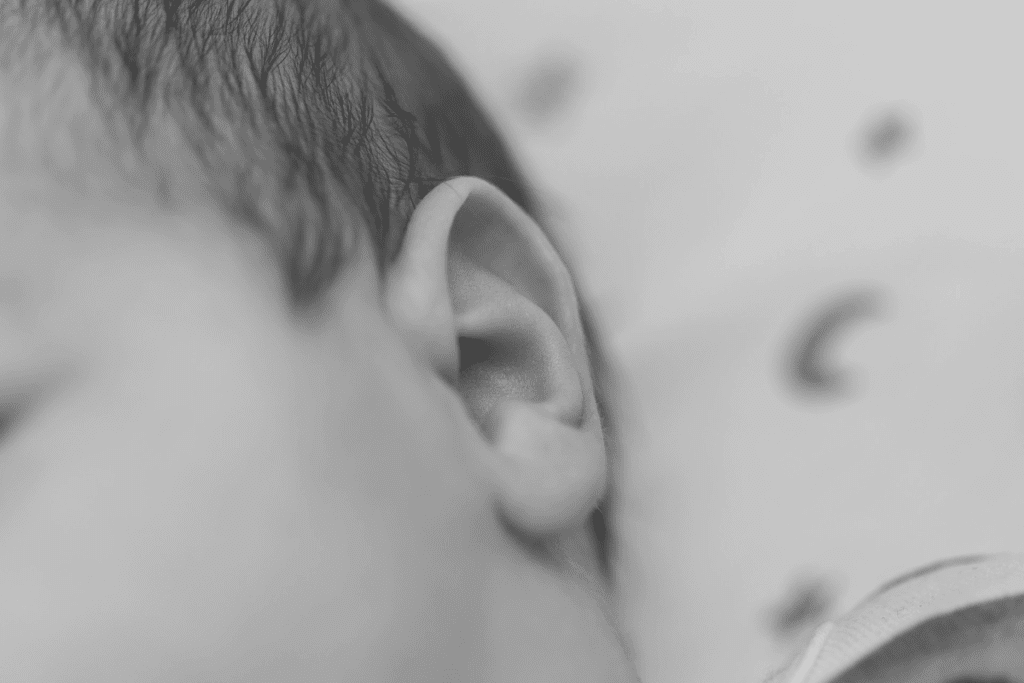
It’s important to spot the early signs of an ear infection quickly. This helps avoid serious problems that could harm your hearing and daily life.
At Liv Hospital, we focus on you. We use the latest medical knowledge to help treat ear infections well.
If you feel ear pain, notice drainage, or have trouble hearing, it’s key to know what’s happening. Understanding symptoms of ear infections in adults helps you get the right help fast.
We’ll talk about common symptoms and how ear drops for infection can help. It’s important to know about ear infection symptoms and treatment choices.
How to know if you have an ear infection: Learn the symptoms and when to use prescription or over-the-counter ear drops for infection.

It’s important to know why ear infections happen and how common they are. Ear infections, also called otitis, can hurt and lead to bigger problems if not treated right.
Ear infections usually come from bacteria or viruses in the middle ear. They often start from a cold or flu. This makes the Eustachian tube block, causing fluid and infection in the middle ear.
Bacterial and Viral Causes: The main culprits are Streptococcus pneumoniae, Haemophilus influenzae, and viruses like respiratory syncytial virus (RSV).
Ear infections hit kids hard, mainly those 6 months to 2 years old. Their Eustachian tubes are shorter and more horizontal, making them more likely to get infections.
Age-Specific Prevalence: Kids under 2 are more at risk because of their Eustachian tube shape and growing immune systems. Adults can get ear infections too, often because of allergies or sinus problems.

Ear infections are not just one thing. They are different infections that affect different parts of the ear. Knowing the differences is key to treating them right.
Middle ear infections, or otitis media, happen in the air space behind the eardrum. They are common, mainly in kids, and can be from bacteria or viruses. Symptoms include ear pain, fever, and trouble hearing.
Characteristics of Middle Ear Infections:
Outer ear infections, or otitis externa, happen in the ear canal. They are often from bacteria or fungi, more so in swimmers or those with ear trauma. Symptoms include itching, redness, and ear canal discomfort.
Characteristics of Outer Ear Infections:
Inner ear infections, known as labyrinthitis, are less common but serious. They affect the inner ear, which controls balance and hearing. Symptoms include dizziness, vertigo, hearing loss, and nausea.
Characteristics of Inner Ear Infections:
Type of Ear Infection | Common Symptoms | Causes |
Middle Ear Infections (Otitis Media) | Ear pain, fever, hearing loss | Bacteria, viruses |
Outer Ear Infections (Otitis Externa) | Itching, redness, discharge | Bacteria, fungi |
Inner Ear Infections (Labyrinthitis) | Dizziness, hearing loss, nausea | Viral infections |
Knowing the signs of an ear infection is key for adults to get the right treatment. Ear infections can make life uncomfortable and disrupt daily activities.
Ear pain or discomfort is a common symptom in adults. The pain can be mild or severe and may feel sharp or dull. It can be constant or come and go.
Adults with ear infections might notice hearing changes. They might hear things muffled or feel like their ear is full. This can happen in one or both ears.
Ear infections can also cause drainage or discharge from the ear. This discharge can be clear, yellow, or even bloody. It often means there’s a perforated eardrum or a serious infection.
It’s important to know the difference between mild and severe symptoms. Mild symptoms might be slight discomfort or hearing changes. Severe symptoms include intense pain, big hearing loss, or fever. Knowing the severity helps decide what to do next.
Understanding these symptoms can help adults spot an ear infection and get medical help if needed. If you’re feeling any of these symptoms, seeing a doctor is a must for the right diagnosis and treatment.
Spotting ear infections in kids is key. They can’t tell us when they’re in pain. So, we must watch for signs that show they might be sick.
Young kids show ear infections in different ways. Look out for:
Older kids can tell us when they’re sick. They might say:
It’s important to listen to what they say. Early treatment can help a lot.
Watch out for these signs and get help fast:
Acting quickly can stop bigger problems and help your child get better faster.
Spotting the first signs of an ear infection is key to better treatment. We often miss these early signs, thinking they’re just minor issues. Knowing these signs can help us get medical help quickly.
The start of an ear infection might show as mild ear pain or a feeling of fullness. You might also notice slight hearing changes. These initial warning signals are subtle, so we must stay alert. Other signs include a slight fever or feeling of pressure in the ear.
It’s important to remember that these symptoms can differ from person to person. Some might feel symptoms slowly getting worse, while others might notice them suddenly.
Telling apart the early signs of an ear infection from other ear problems is critical. Issues like otitis externa or Eustachian tube dysfunction can look similar. This makes it hard to figure out what’s wrong.
To correctly diagnose an ear infection, we need to look at all symptoms together. Ear infections usually cause pain, hearing changes, and sometimes discharge. Knowing these details helps us tell ear infections apart from other ear issues.
By knowing the early signs and how to tell them apart from other problems, we can get the right medical care. This ensures we get the best treatment and avoid serious issues.
To figure out if you have an ear infection, start by checking your symptoms at home. Then, see a healthcare professional. This two-step process helps get a correct diagnosis.
Before you see a doctor, check yourself for signs of an ear infection. Look for symptoms like:
If you notice many of these signs, you might have an ear infection.
A healthcare professional will use an otoscope to look at your ear. This tool lets them see inside the ear canal and eardrum. They look for signs of infection like redness, swelling, or fluid.
Depending on your case, your doctor might do more tests. These can include:
These tests help your doctor understand how bad the infection is. They then choose the best treatment for you.
Ear drops are a common and effective way to treat ear infections. They come in different types, each with its own active ingredients and uses.
Antibiotic ear drops are made to fight bacterial infections in the ear. They contain antibiotics that kill the bacteria causing the infection.
These drops fight bacterial infections and also reduce inflammation. This helps to quickly ease symptoms like pain and swelling.
Over-the-counter (OTC) ear drops can help with ear pain and wax buildup. But, they might not work against bacterial infections.
Prescription ear drops, like antibiotic and combination drops, are better for bacterial infections. Non-prescription drops are good for mild symptoms or as a preventive measure.
Here’s a comparison of the different types of ear drops:
Type of Ear Drops | Active Ingredients | Primary Use |
Antibiotic Ear Drops | Antibiotics (e.g., neomycin, polymyxin B) | Treat bacterial ear infections |
Combination Antibiotic and Steroid Drops | Antibiotics + Steroids (e.g., hydrocortisone) | Treat bacterial infections and reduce inflammation |
Over-the-Counter Ear Drops | Varies (e.g., pain relievers, wax dissolvers) | Relieve ear pain, dissolve earwax |
It’s important to talk to a healthcare professional to find the right ear drops for you. They can help decide if you need prescription or over-the-counter drops.
To get the most out of your ear drops, it’s essential to apply them correctly. The effectiveness of the treatment largely depends on the proper application technique. We will guide you through the steps to ensure you’re using your ear drops effectively.
Applying ear drops can be a straightforward process if done correctly. Here’s a step-by-step guide:
To maximize the effectiveness of your ear drops, follow these tips:
Avoiding common mistakes can significantly improve the effectiveness of your ear drops. Here are some mistakes to watch out for:
Mistake | Consequence | Correction |
Not tilting the head correctly | Drops may not reach the eardrum | Tilt head to the side and gently pull the outer ear |
Using expired drops | Reduced effectiveness or irritation | Check expiry date before use |
Not wiping away excess drops | Potential for drops to spill out and not be fully absorbed | Wipe away excess drops after application |
By following these guidelines and avoiding common mistakes, you can ensure that your ear drops are applied correctly and effectively. This will enhance your recovery from an ear infection.
Ear infections need more than just ear drops. Sometimes, other treatments are needed to help symptoms and aid in recovery.
For severe or ongoing ear infections, doctors might prescribe oral antibiotics. These medicines fight bacterial infections, which are common causes of ear infections. It’s important to take all the antibiotics as told by your doctor to clear the infection.
Key considerations for oral antibiotics include:
Managing pain is key when treating ear infections. Over-the-counter pain relievers like acetaminophen or ibuprofen can help. Always follow the dosage instructions and talk to a doctor if the pain doesn’t get better or gets worse.
Effective pain management can greatly improve life for those with ear infections.
Some home remedies can help with ear infection symptoms. A warm compress on the ear can ease pain. Also, sleeping with your head raised can help reduce ear pressure.
Popular home remedies include:
While these remedies can help, they shouldn’t replace medical treatment. Always talk to a healthcare professional to find the best treatment for your ear infection.
Knowing the recovery timeline for ear infections is key. It helps you manage your daily life while you heal. When you start treatment, understanding how your body will react is important.
Ear infections often get better in 48 to 72 hours after treatment starts. It’s vital to follow your doctor’s advice and finish the treatment. You might start feeling better in a few days, but keep going with the treatment.
Some discomfort or hearing changes are normal in the first few days. But, if your symptoms get worse or you have severe pain, call your doctor right away.
The complete recovery process can take up to two weeks. Be patient and don’t rush back to hard activities too soon. Your hearing and balance might be off during this time, so be careful.
Start getting back to normal activities slowly. Pay attention to your body and avoid anything that hurts or causes discomfort in your ears.
Showering and swimming need caution with an ear infection. Keeping your ears dry is important to avoid more irritation or infection. Use earplugs or a shower cap when showering.
Avoid swimming until your doctor says it’s okay. If you swim, use earplugs and don’t dive or jump into the water. It can make your condition worse.
Using cotton in infected ears is not advised. It can push debris deeper into your ear or irritate it. If you need to dry your ears after showering, gently pat the outer ear with a towel.
Don’t put anything into your ear canal. It can cause more irritation or even damage your eardrum.
If you think you have an ear infection, knowing when to see a doctor is key. Some ear infections might get better on their own. But, some need quick medical help to avoid serious problems or to feel better.
There are clear signs that mean you should see a doctor for an ear infection. These include:
As a medical expert says, “Seeing a doctor early is important to avoid serious problems from ear infections.”
“If you see discharge or fluid from your ear, it might mean your eardrum is torn. You need to see a doctor right away.”
If your ear infection symptoms don’t go away or get worse after treatment, you should see your doctor again. This could mean the infection is not fully gone or there’s another issue that needs checking.
Some age groups need extra care when it comes to ear infections. For example:
If you’re not sure about your symptoms or are in a high-risk age group, it’s best to talk to a healthcare professional.
Ear infections are common and can really disrupt daily life. But, with the right approach, they can be managed well. We’ve talked about the different types of ear infections, their signs, and how to treat them, including using ear drops.
Understanding how to treat ear infections is key. This includes getting the right diagnosis and using medicines like antibiotic ear drops. Knowing when to see a doctor is also vital to avoid serious problems and get better fast.
Spotting symptoms early and sticking to treatment plans can help a lot. It’s important to see a healthcare expert for advice on dealing with ear infections.
In short, being aware and acting quickly is essential in treating ear infections. With proper care, people can get back to their usual lives.
Ear infections cause pain and discomfort. You might notice hearing changes or see discharge. If you have these signs, see a doctor.
Adults with ear infections might feel pain or hear differently. You could see discharge or feel fullness. Some also get fever, headache, or dizziness.
Recovery time varies by infection type and treatment. Most start to feel better in a few days. Full recovery usually takes one to two weeks.
It’s okay to shower with an ear infection, but avoid water in your ear canal. Use earplugs or a shower cap to keep your ears dry.
Telling ear infections from other conditions is hard. If symptoms last or are severe, see a doctor for a diagnosis.
Doctors might prescribe antibiotic, antibiotic and steroid, or pain-relieving ear drops. The choice depends on the infection’s type and severity.
To use ear drops right, tilt your head and pull your ear back and up. Put in the drops and keep your head tilted for a few minutes.
Don’t put cotton or objects in your ear canal. It can push wax in and harm your eardrum. Dry your outer ear with a clean towel instead.
See a doctor for severe symptoms, pain that doesn’t go away, fever over 102°F, or if symptoms get worse or don’t get better.
Kids get ear infections more often because of their eustachian tube. But adults can get them too, if they have health issues or allergies.
Preventing ear infections is hard, but you can lower the risk. Get vaccinated, avoid secondhand smoke, and stay clean to help.
Morgenthaler, T. I., Kagramanov, V., Hanak, V., & Decker, P. A. (2006). Complex sleep apnea syndrome: Is it a unique clinical syndrome? Sleep, 29(9), 1203-1209. [https://academic.oup.com/sleep/article/29/9/1203/2708307]
Subscribe to our e-newsletter to stay informed about the latest innovations in the world of health and exclusive offers!
WhatsApp us